Rancho Cucamonga, California
Rancho Cucamonga (/ˌræntʃoʊ kuːkəˈmʌŋɡə/ RAN-choh KOO-kə-MUNG-gə) is a city located just south of the foothills of the San Gabriel Mountains and Angeles National Forest in San Bernardino County, California, United States. About 37 miles (60 km)[12] east of Downtown Los Angeles, Rancho Cucamonga is the 28th most populous city in California. The city's seal, which centers on a cluster of grapes, alludes to the city's agricultural history including wine-making.[13] The city's proximity to major transportation hubs, airports, and highways has attracted the business of several large corporations, including Coca-Cola, Frito-Lay, Big Lots, Mercury Insurance Group, Southern California Edison, and Amphastar Pharmaceuticals.[14][15]
Rancho Cucamonga, California | |
|---|---|
| City of Rancho Cucamonga | |
 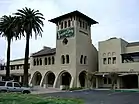 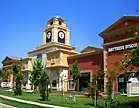 Cucamonga Peak (top), Virginia Dare Winery (left), and shops in Rancho Cucamonga (right) | |
 Flag  Seal | |
| Motto: A World Class Community | |
 Location of Rancho Cucamonga in San Bernardino County | |
 Rancho Cucamonga, California Location in the United States | |
| Coordinates: 34°7′24″N 117°34′46″W | |
| Country | United States |
| State | California |
| County | San Bernardino |
| Incorporated (city) | November 30, 1977[1] |
| Government | |
| • Type | Council-Manager |
| • City council[2] | Mayor L. Dennis Michael Mayor pro tem Lynne Kennedy Ryan A. Hutchinson Kristine D. Scott Sam Spagnolo |
| • City clerk | Janice C. Reynolds[3] |
| • City treasurer | James C. Frost[4] |
| • City manager | John Gillison[5] |
| • City attorney | James L. Markman[6] |
| Area | |
| • Total | 40.12 sq mi (103.91 km2) |
| • Land | 40.11 sq mi (103.89 km2) |
| • Water | 0.01 sq mi (0.02 km2) 0.05% |
| Elevation | 1,207 ft (368 m) |
| Population | |
| • Total | 174,453 |
| • Rank | 4th in San Bernardino County 26th in California 145th in the United States |
| • Density | 4,349.36/sq mi (1,679.21/km2) |
| Time zone | UTC−8 (PST) |
| • Summer (DST) | UTC−7 (PDT) |
| ZIP Code | 91701, 91729, 91730, 91737, 91739[10] |
| Area code(s) | 909, 840[11] |
| FIPS code | 06-59451 |
| GNIS feature ID | 1667908 |
| Website | www |
The city had a population of 174,453 according to the 2020 United States Census. The city experiences an average of 287 sunny days per year, compared to a national average of 205 days.[16] Its climate is classified as warm Mediterranean, or Csa, under the Köppen climate classification system.[17]
The city's favorable location and host of public amenities have earned it numerous distinctions. Notably, Money Magazine ranked Rancho Cucamonga 42nd on its "Best Places to Live" list in 2006.[18] In addition, Business Insider established one Rancho Cucamonga neighborhood as the 13th richest neighborhood in Southern California.[19] The four public high schools (Alta Loma, Etiwanda, Los Osos, and Rancho Cucamonga) earned the Silver distinction in a 2015 ranking of the nation's high schools by U.S. News & World Report.[20] In 2017 the California Department of Education announced that all four high schools were being named California Gold Ribbon Schools.[21]
The Jack Benny Program popularized the city's name, in particular the word "Cucamonga".[22]
History
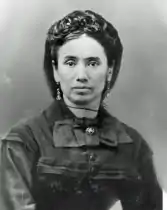
By 1200 AD, Kukamongan Native Americans had established a village settlement in the area around present-day Red Hill, near the city's western border, where Red Hill Country Club stands today. Kukamonga derives its name from a Tongva word meaning "sandy place."[23] Anthropologists have determined that this cluster of settlers likely belonged to the Tongva people or Kich people, at one time one of the largest concentrations of Native American peoples on the North American continent.[24] In the 18th century, following an expedition led by Gaspar de Portola, the land was incorporated into the Mission System established by Father Junipero Serra and his group of soldiers and Franciscan friars.
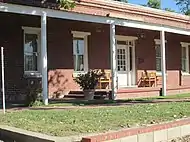
After a half century of political jockeying in the region, the land finally came under the control of Juan Bautista Alvarado, governor of Mexico. On March 3, 1839, Alvarado granted 13,000 acres of land in the area called "Cucamonga" to Tubercio Tapia, a first-generation Spanish native of Los Angeles, successful merchant, and notorious smuggler.[24][25] Tapia went on to establish the first winery in California on his newly deeded land.[23][24][26][27] Rancho Cucamonga was purchased by John Rains and his wife in 1858. The Rains family's home, Casa de Rancho Cucamonga, was completed in 1860 and now appears on the National Register of Historic Places.[23][28]
During the ensuing years the town prospered and grew. In 1887, irrigation tunnels were dug into Cucamonga Canyon by Chinese laborers and the Santa Fe Railroad was extended through the area. Among the town's economic mainstays was agriculture, including olives, peaches, citrus, and, most notably, vineyards.[23] In 1913, the Pacific Electric Railway was extended through Rancho Cucamonga in an effort to improve crop transportation. Several landmarks in existence today pay tribute to the city's multicultural founding. In particular, Our Lady of Mt. Carmel[29] remains as a relic of the area's Mexican agriculture laborers while the Chinatown House[30] stands as a reminder of the Chinese immigrants who labored in constructing the area's infrastructure.[24]
In 1977, the unincorporated communities of Alta Loma, Cucamonga, and Etiwanda voted to incorporate, forming the city of Rancho Cucamonga.[31]
Grapeland
The former community of Grapeland, first settled in 1869, lay roughly between today's Victoria Groves Park and Central Park. There was a schoolhouse which also doubled as a church. In 1890 an irrigation district was formed and $200,000 in bonds were sold to pay for improvements. The Sierra Vista reservoir was built in 1886-87 by J.L. Scofield as the focal point of a network of irrigation pipes. The system was unused, however, because the bond issue was declared illegal. "Orchards and vineyards began to die," The Daily Report newspaper reported in a retrospective. "Residents moved out. The post office closed in 1905. Homes, buildings were destroyed or abandoned." The reservoir remained unused until 1956, when the Fontana Union Water Company filled it with 5 million gallons of water. The local school district was merged with the Etiwanda district in 1901. In 1957 the settlement was practically deserted, but there were still rabbit-proof stone walls marking boundaries of previous citrus orchards.[32]
Geography
Rancho Cucamonga is part of the Inland Empire and San Bernardino County, a region that lies inland from the Pacific coast and directly east of Los Angeles County. Rancho Cucamonga is located about 37 miles (60 km) east of Los Angeles, bordered by Upland to its west, Ontario to its south, the San Gabriel Mountains to its north and I-15 and Fontana to its east.[12] The city sits atop an alluvial plain and views of Cucamonga Peak, one of the tallest peaks of the San Gabriel Mountains, are available from all points throughout the city.[33] The city has a total area of 39.9 square miles (103 km2), 99.95% of which is land and 0.05% water.[34]
Climate
The city's climate is classified as hot-summer Mediterranean, or Csa, under the Köppen climate classification system.[17] Yearly precipitation is 17.68 inches (449 mm) and the city experiences an average of 287 sunny days per year, compared to a national average of 205 days.[16]
| Climate data for Rancho Cucamonga, California (1987–2016; extremes since 1909) | |||||||||||||
|---|---|---|---|---|---|---|---|---|---|---|---|---|---|
| Month | Jan | Feb | Mar | Apr | May | Jun | Jul | Aug | Sep | Oct | Nov | Dec | Year |
| Record high °F (°C) | 90 (32) |
90 (32) |
97 (36) |
110 (43) |
107 (42) |
115 (46) |
112 (44) |
111 (44) |
112 (44) |
110 (43) |
98 (37) |
93 (34) |
115 (46) |
| Average high °F (°C) | 66.2 (19.0) |
68.5 (20.3) |
69.3 (20.7) |
74.3 (23.5) |
79.0 (26.1) |
86.0 (30.0) |
93.9 (34.4) |
93.7 (34.3) |
89.4 (31.9) |
82.2 (27.9) |
72.3 (22.4) |
66.9 (19.4) |
78.4 (25.8) |
| Average low °F (°C) | 41.4 (5.2) |
43.0 (6.1) |
44.1 (6.7) |
46.9 (8.3) |
51.4 (10.8) |
55.9 (13.3) |
61.2 (16.2) |
62.1 (16.7) |
59.0 (15.0) |
53.2 (11.8) |
45.7 (7.6) |
41.4 (5.2) |
52.5 (11.4) |
| Record low °F (°C) | 25 (−4) |
29 (−2) |
30 (−1) |
33 (1) |
38 (3) |
43 (6) |
52 (11) |
51 (11) |
47 (8) |
40 (4) |
26 (−3) |
24 (−4) |
24 (−4) |
| Average rainfall inches (mm) | 4.16 (106) |
5.14 (131) |
2.70 (69) |
1.10 (28) |
0.44 (11) |
0.21 (5.3) |
0.07 (1.8) |
0.04 (1.0) |
0.25 (6.4) |
0.93 (24) |
1.22 (31) |
1.42 (36) |
17.68 (450.5) |
| Average rainy days (≥ 0.01 inch) | 7.2 | 6.7 | 7.7 | 4.1 | 2.8 | 1.6 | 0.5 | 0.7 | 1.7 | 2.6 | 3.4 | 4.8 | 43.8 |
| Source: [35] | |||||||||||||
Demographics
| Historical population | |||
|---|---|---|---|
| Census | Pop. | %± | |
| 1980 | 55,250 | — | |
| 1990 | 101,409 | 83.5% | |
| 2000 | 127,743 | 26.0% | |
| 2010 | 165,269 | 29.4% | |
| 2020 | 174,453 | 5.6% | |
2010
The 2010 United States Census[36] reported that Rancho Cucamonga had a population of 165,269. The population density was 4,145.2 inhabitants per square mile (1,600.5/km2). The racial makeup of Rancho Cucamonga was 102,401 (62.0%) White (42.7% Non-Hispanic White), 15,246 (9.2%) African American, 1,134 (0.7%) Native American, 17,208 (10.4%) Asian, 443 (0.3%) Pacific Islander, 19,878 (12.0%) from other races, and 8,959 (5.4%) from two or more races. There were 57,688 residents of Hispanic or Latino ancestry, of any race (34.9%).
The census reported that 162,145 people (98.1% of the population) lived in households, 136 (0.1%) lived in non-institutionalized group quarters, and 2,988 (1.8%) were institutionalized.[37]
Out of a total of 54,383 households, 23,055 (42.4%) had children under the age of 18 living in them, 30,533 (56.1%) were opposite-sex married couples living together, 7,514 (13.8%) had a female householder with no husband present, and 3,257 (6.0%) had a male householder with no wife present, as well as 2,995 (5.5%) unmarried opposite-sex partnerships and 425 (0.8%) same-sex married couples or partnerships. 9,956 households (18.3%) were made up of individuals, and 2,679 (4.9%) had someone living alone who was 65 years of age or older. The average household size was 2.98. Over the 41,304 families (76.0% of all households), the average family size was 2.90.[38]
The age distribution of the city was as follows: 42,550 people (25.7%) under the age of 18, 17,365 people (10.5%) aged 18 to 24, 48,600 people (29.4%) aged 25 to 44, 43,710 people (26.4%) aged 45 to 64, and 13,044 people (7.9%) who were 65 years of age or older. The median age was 34.5 years. For every 100 females, there were 97.6 males. For every 100 females age 18 and over, there were 95.2 males.
There were 56,618 housing units at an average density of 1,420.1 per square mile (548.3/km2), of which 35,250 (64.8%) were owner-occupied, and 19,133 (35.2%) were occupied by renters. The homeowner vacancy rate was 1.6%; the rental vacancy rate was 5.2%. 110,570 people (66.9% of the population) lived in owner-occupied housing units and 51,575 people (31.2%) lived in rental housing units.
During 2009–2013, Rancho Cucamonga had a median household income of $77,835, with 6.9% of the population living below the federal poverty line.[39]
2000
As of the 2000 census, there were 127,743 people, 40,863 households, and 31,832 families residing in the city. The population density was 1,317.0/km2 (3,411.4/mi2). There were 42,134 housing units at an average density of 434.4/km2 (1,125.2/mi2). The racial makeup of the city was 66.53% White, 9.00% Asian, 0.67% Native American, 5.99% African American, 0.27% Pacific Islander, 13.25% from other races, and 5.41% from a biracial or multiracial background. Hispanic or Latino of any race were 27.78% of the population.
There were 40,863 households, of which 44.7% had children under the age of 18. 60.2% of households consist of a married couple living together. 12.8% had a female householder with no husband present. 22.1% were non-families. 16.8% of all households were single-person and 4.1% had a person of 65 years of age or older. The average household size was 3.04 and the average family size was 3.44.
In the city, the population spread was as follows: 29.9% were under the age of 18, 9.9% were from 18 to 24, 33.2% were from 25 to 44, 21.0% were from 45 to 64, and 6.1% were 65 years of age or older. The median age was 32 years. For every 100 females, there were 100.1 males. For every 100 females age 18 and over, there were 98.0 males.
The median income for a household in the city was $78,428 and the median income for a family was $91,240. Males had a median income of $50,288 versus $40,952 for females. The per capita income for the city was $23,702. About 4.9% of families and 7.1% of the population were below the poverty line, including 7.6% of those under age 18 and 7.3% of those age 65 or over.

Economy
In 2006, Money magazine ranked the city 42nd on its "Best Places to Live" list.[18] Business Insider magazine ranked Haven View Estates, one of the city's many gated communities, 13th on its list of "The 27 Richest Neighborhoods in Southern California", just behind the Los Angeles neighborhood of Bel Air, which ranked 12th.[19]
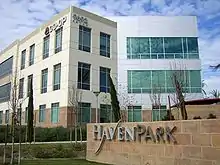
While most of the city's land area is devoted to residential areas, Rancho Cucamonga, like its neighbors Ontario and Fontana, is a major center for the logistics industry in Southern California. This is due to its proximity to two interstate highways and Ontario International Airport, and the space afforded by the large tracts of former agricultural land in the southern section of the city.[40]
In the area around Milliken Avenue, between Archibald and Etiwanda Avenues, Foothill Boulevard, and Fourth Street, about seven square miles of land are primarily occupied by numerous massive distribution centers, and even more, smaller manufacturing companies. This area is ringed by office parks, mostly along Haven Avenue, and shopping strips, such as the Terra Vista Town Center (part of a nearly two-square-mile master-planned community in the center of the city), and malls, such as Victoria Gardens, and the Ontario Mills, across Fourth Street in Ontario.[41]
The city is also home to a CMC Steel (Formerly Gerdau, Formerly TAMCO Steel) minimill, the only producer of long steel in California. This mill recycles ferrous scrap, such as junked cars and appliances, to produce rebar.[42][43][44]
The city hosts LoanMart Field, (formerly known as The Epicenter), a minor-league baseball stadium, home of the Rancho Cucamonga Quakes. The Quakes' mascot, Tremor, is a "Rallysaurus."[45]
Victoria Gardens
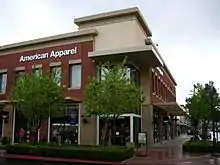
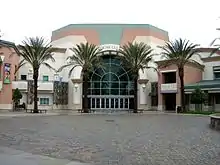
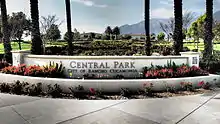
Victoria Gardens is a lifestyle center near the eastern end of the city, at the intersection of Foothill and Day Creek Boulevards. Since the city had never developed a traditional commercial downtown like neighboring cities Ontario and Upland had, efforts were made in the design of Victoria Gardens to bring elements of more traditional and urban town design to what had historically been a suburban city. While retaining many characteristics of traditional shopping malls, such as large anchor stores, a food court, and vast parking lots and garages, the smaller stores are arranged as city blocks in a grid of two-lane streets, featuring lush landscaping and metered "teaser parking" in front of the stores, which open onto the sidewalk. There are two "Main Streets", which run from west to east across the center. Running from north to south between them is a pedestrian axis leading from one of the Macy's anchor stores, through a "town square" between a pair of mixed-use office buildings, to the Victoria Gardens Cultural Center, which contains the Lewis Playhouse (a 570-seat theater) and a branch of the city library. The east side of the development has Southern California's only Bass Pro Shops Outdoor World superstore; the 180,000-square-foot (17,000 m2) facility includes a Tracker Boat Center and the Islamorada Fish Company restaurant.[46] There are restaurants throughout the center, both well-known chains and unique eateries, including California Pizza Kitchen, The Cheesecake Factory, Fleming's, Gyu-Kaku Japanese BBQ Dining, Johnny Rockets, King's Fish House, Lucille's BBQ, N7 Creamery, P.F. Chang's China Bistro, Richie's Diner, T.G.I. Friday's, and Yard House. The center features a 12-screen AMC Theatre.
Top employers
According to the city's 2018 Comprehensive Annual Financial Report, the principal employers in the city are:[15]
| Rank | Employer | # of employees | % of total employment |
|---|---|---|---|
| 1 | Inland Empire Health Plan | 2315 | 2.50% |
| 2 | Etiwanda School District | 2293 | 2.47% |
| 3 | Chaffey Community College | 2111 | 2.28% |
| 4 | Alta Loma School District | 1095 | 1.18% |
| 5 | City of Rancho Cucamonga | 865 | 0.93% |
| 6 | Amphastar Pharmaceutical | 643 | 0.69% |
| 7 | Mercury Insurance Company | 632 | 0.68% |
| 8 | Macy's | 615 | 0.65% |
| 9 | Central School District | 605 | 0.65% |
| 10 | Big Lots Distribution Center | 600 | 0.54% |
Government
Local government
Rancho Cucamonga is a General Law City, incorporated in 1977 under the "Council-Manager" form of local government. The four-member Council, plus the Mayor, City Clerk, and City Treasurer, are all elected at-large by the voters of the city. The Council then appoints the City Manager, who acts as the administrative head of the city government, and is responsible for the day-to-day operations, code enforcement, and the fiscal soundness of the municipal government. The council itself serves as a local legislative body. The city's elections, which are plurality, are held on a Tuesday after the first Monday in November of even-numbered years.
L. Dennis Michael has been the city's mayor since 2011, with John Gillison as the city manager.
According to a city Comprehensive Annual Financial Report, the city's various funds had $278.3 million in revenues, $243.6 million in expenditures, $1,400.7 million in total assets, $492.1 million in total liabilities, and $583.3 million in cash and investments.[47]
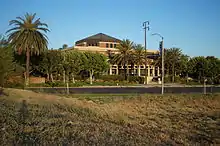
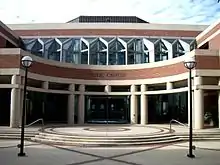
Politics
In the California State Legislature, Rancho Cucamonga is in the 23rd Senate District, represented by Republican Rosilicie Ochoa Bogh, and in the 40th Assembly District, represented by Democrat James Ramos.[48]
In the United States House of Representatives, Rancho Cucamonga is in California's 31st congressional district, represented by Democrat Pete Aguilar.[49]
In 2005, the non-partisan Bay Area Center for Voting Research ranked Rancho Cucamonga as the 28th most conservative city in the United States.[50]
| Year | Democratic | Republican | Third Parties |
|---|---|---|---|
| 2020[52] | 51.85% 45,190 | 46.15% 40,220 | 2.00% 1,744 |
| 2016[53] | 49.21% 33,428 | 45.22% 30,715 | 5.57% 3,780 |
| 2012[54] | 48.35% 30,667 | 49.65% 31,496 | 2.00% 1,267 |
| 2008[55] | 49.49% 31,796 | 48.70% 31,289 | 1.80% 1,158 |
| 2004[56] | 39.68% 21,050 | 59.47% 31,550 | 0.86% 454 |
| 2000[57] | 43.09% 18,637 | 53.80% 23,268 | 3.11% 1347 |
| 1996[58] | 40.04% 14,831 | 49.25% 18,245 | 10.71% 3,967 |
| 1992[59] | 33.09% 13,530 | 42.19% 17,254 | 24.72% 10,110 |
| 1988[60] | 30.90% 9,468 | 68.09% 20,864 | 1.02% 312 |
| 1984[61] | 24.94% 5,394 | 74.06% 16,016 | 0.99% 215 |
| 1980[62] | 24.56% 4,347 | 66.56% 11,782 | 8.88% 1,572 |
Law enforcement
Since incorporation in 1977, law enforcement services in Rancho Cucamonga City have been provided through a contract with the San Bernardino County Sheriff's Department.[63]
Rancho Cucamonga is also home to the Foothill Communities San Bernardino County Courthouse, which is housed in a building adjacent to the Rancho Cucamonga Civic Center, in a government complex located at Haven Avenue and Civic Center Drive in the city. The Civic Center houses the Rancho Cucamonga city hall, the city police department, and other local government offices.[64]
Education
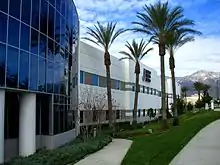

Schools
Rancho Cucamonga has multiple public K–12 schools, operating under several different school districts, within its borders: Alta Loma School District, Central School District, Cucamonga School District, Etiwanda School District, and Chaffey Joint Union High School District. Private schools include Upland Christian Academy. In addition, Rancho Cucamonga is the home to Chaffey College and satellite campuses of the University of La Verne, Cambridge College, University of Redlands, Everest College, and University of Phoenix, as well as the automotive trade school.
High Schools
- Alta Loma High School
- Etiwanda High School
- Los Osos High School
- Rancho Cucamonga High School
Libraries
The city of Rancho Cucamonga has two public libraries, with a combined total of over 200,000 volumes. The library at 7368 Archibald Avenue opened in 1994 and was remodeled in the summer of 2008. The Paul A. Biane library at 12505 Cultural Center Drive at the Victoria Gardens Cultural Center opened in August 2006. In 2013, the Rancho Cucamonga Public Library was a recipient of the National Medal for Museum and Library Services, the nation's highest honor that can be bestowed on a Library or Museum.[65]
Infrastructure

Rancho Cucamonga's location at the base of the San Gabriel Mountains has necessitated the use of numerous control channels and basins to reduce the seasonal flood danger from the several streams descending from the range. In past years, some of the city's roads were known for flooding. Hermosa Avenue, in particular, now features many high curbs and extra-large storm drain grates to reduce flooding.
Transportation
Rancho Cucamonga is served by Omnitrans bus service, train service from Metrolink's Rancho Cucamonga station on the San Bernardino Line, and nearby Ontario International Airport, one of four major Los Angeles-area passenger airports with multiple daily flights by most domestic carriers as well as a major shipping hub for companies like UPS and FedEx.
Interstate 15 (I-15) and State Route 210 (SR-210) run through Rancho Cucamonga as well as the historic U.S. Route 66 (as Foothill Boulevard).
I-15 sits atop an elevated berm, and cuts a curve through the southeastern part of the city, isolating a mostly industrial area, a small shopping center, and several housing tracts from the larger part of the city. Further north, I-15 forms part of the northeastern border with neighboring Fontana before entering the Cajon Pass through the San Gabriel Mountains. I-15 provides connectivity with the High Desert, Nevada, and points north for the Inland Empire and much of Southern California.
SR-210 runs nearly straight east–west through the northern part of the city, roughly bisecting the residential communities of Alta Loma and Etiwanda, providing connection (in addition to I-10 and SR-60) from the San Gabriel Valley and points west to the San Bernardino area.
Utilities
Rancho Cucamonga receives natural gas from the Southern California Gas Company. The city's water supply and sewage are managed by the Cucamonga Valley Water District. Garbage collection is by Burrtec Disposal, phone service is from Frontier Communications[66] and cable TV is provided by Charter Communications.[67]
Electric power in Rancho Cucamonga is provided by Southern California Edison and the Rancho Cucamonga Municipal Utility, and the city is also home to the Reliant Energy Etiwanda Generating Station, on Etiwanda Avenue. This facility, one of five Reliant stations in California, is a natural gas-fired power plant, which began operation in 1963. At 640 megawatts (860,000 hp) net capacity, it is Reliant's second-highest capacity plant on the West Coast. It utilizes four steam turbine generators; of which units three and four remained active after turbines one and two, as well as a combustion turbine, were retired in 2003 and 2004, respectively. Several systems are in place to control gas emissions, and annually, over 900,000,000 US gallons (750,000,000 imp gal; 3.4 GL) of recycled water are used for cooling.[68][69]
On November 29, 2011, the Inland Empire Utilities Agency installed the first wind turbine in Rancho Cucamonga.[70]
In popular culture
The name "Cucamonga" became well known to fans of Jack Benny's popular radio program, in which an announcer, voiced by Mel Blanc, would call out: "Train leaving on track five for Anaheim, Azusa and Cu-camonga!" This running gag became so well known that it eventually led to a statue of Benny in Cucamonga.[71][72]
The city is also the primary setting of the show Workaholics, and the movie Next Friday. Further mention of the city was made in the Netflix series Unsolved.
The city was claimed as the birthplace of the "Flamin' Hot" flavor of Cheetos, by Richard Montañez, supposedly in the 1980s at the Frito-Lay factory.[73] The story is the subject of an upcoming biopic directed by Eva Longoria.[74] However, a Los Angeles Times exposé in May 2021 revealed Montañez's claim to be a hoax.[75]
A sketch from The Eric Andre Show features Andre, posing as a frat boy, commendeering the microphone at Rancho Cucamonga city council meeting, urging the citizens to vote for him for class president. The stunt resulted in Andre's arrest.
Cucamonga is referenced in the Grateful Dead song "Pride of Cucamonga" on the From the Mars Hotel album, and in "Cucamonga" on Frank Zappa’s album Bongo Fury.
See also
- List of people from Rancho Cucamonga, California
- List of U.S. cities with large Hispanic populations
References
- "California Cities by Incorporation Date". California Association of Local Agency Formation Commissions. Archived from the original (Word) on November 3, 2014. Retrieved August 25, 2014.
- "Mayor & City Council". Rancho Cucamonga. Retrieved January 30, 2019.
- "City Clerk's Office". Rancho Cucamonga. Archived from the original on April 10, 2015. Retrieved January 19, 2015.
- "City Treasurer James Frost". Rancho Cucamonga. Archived from the original on April 10, 2015. Retrieved January 19, 2015.
- "City Manager's Office". Rancho Cucamonga. Archived from the original on March 18, 2015. Retrieved January 19, 2015.
- "City Attorney". Rancho Cucamonga. Retrieved January 30, 2019.
- "2019 U.S. Gazetteer Files". United States Census Bureau. Retrieved July 1, 2020.
- "Rancho Cucamonga". Geographic Names Information System. United States Geological Survey, United States Department of the Interior. Retrieved December 19, 2014.
- "Rancho Cucamonga (city) QuickFacts". United States Census Bureau. Retrieved December 23, 2021.
- "USPS - ZIP Code Lookup - Find a ZIP+ 4 Code By City Results". Retrieved February 20, 2007.
- "Number Administration System - NPA and City/Town Search Results". Archived from the original on September 29, 2007. Retrieved February 20, 2007.
- "Rancho Cucamonga | California, United States". Encyclopædia Britannica. Retrieved February 1, 2016.
- "'Tangled Vines' explores wine, the pride of Cucamonga". www.dailybulletin.com. November 24, 2015. Retrieved February 1, 2016.
- "Rancho Cucamonga - Top 25 Companies by Number of Employees". www.cityofrc.us. Archived from the original on June 14, 2018. Retrieved January 16, 2016.
- Rancho Cucamonga Finance Department. "Comprehensive Annual Financial Report For Fiscal Year Ended June 30, 2018" (PDF). City of Rancho Cucamonga.
- "Rancho_Cucamonga, California Climate". www.bestplaces.net. Retrieved January 14, 2016.
- "California Department of Fish & Wildlife, Atlas of Biodiversity". www.dfg.ca.gov. Retrieved January 16, 2016.
- "MONEY Magazine: Best places to live 2006: Rancho Cucamonga, CA snapshot". CNN. Archived from the original on December 1, 2011. Retrieved December 11, 2011.
- Cooperstein, Paige. "The 27 Richest Neighborhoods In Southern California". Business Insider. Retrieved May 28, 2015.
- "Best High Schools Rankings | Top High Schools | US News". www.usnews.com. Retrieved January 14, 2016.
- "Torlakson Announces 2017 CA Gold Ribbon Schools - Year 2017 (CA Dept of Education)". www.cde.ca.gov. Sacramento, CA: California Department of Education. April 18, 2017. Retrieved November 1, 2018.
- "Jack Benny was a friend to Anaheim – Orange County Register". Orange County Register (in Kinyarwanda). August 18, 2014. Retrieved May 6, 2020.
- "Rancho Cucamonga | California, United States". Encyclopædia Britannica. Retrieved January 15, 2016.
- "Rancho Cucamonga - History of RC". www.cityofrc.us. Archived from the original on October 6, 2018. Retrieved January 15, 2016.
- "RANCHO CUCAMONGA: An old tale of smuggler's gold". Press Enterprise. May 6, 2014. Retrieved January 16, 2016.
- "Thomas Vineyards – California's Oldest Winery". Ginoffvine. May 7, 2010. Retrieved January 16, 2016.
- "San Bernardino". ohp.parks.ca.gov. Retrieved January 16, 2016.
- "National Register of Historic Places Database and Research Page -- National Register of Historic Places Official Website--Part of the National Park Service". www.nps.gov. Retrieved January 16, 2016.
- "Parish History - Our Lady of Mount Carmel". Olmtcarmelranchocucamonga.org. Retrieved January 16, 2016.
- "Chinatown House in Rancho Cucamonga". Los Angeles Times. ISSN 0458-3035. Retrieved January 16, 2016.
- Roger Vincent and Adrian G. Uribarri (November 25, 2006). "Getting the masses in the mood". Los Angeles Times. Retrieved October 29, 2011.
- "Rubble Remains of a Community That Was — Grapeland," The Daily Report, July 13, 1957, page 3 / FONTANA–Between Fontana and Etiwanda lie the dry, dusty remains of a community that died for lack of water. The name of the town was Grapeland. A few people still live in the original tpwnsite, but the brilliant future that was predicted for it in the 1880s never came to pass. Unpaved dirt roads, still graded by San Bernardino County, run spasmodically through the area. Grapevines still cover much of the parched land; but gone are the citrus groves, the fruit trees, the early pioneer settlers. . . . The first settlers came to Grapeland in 1869. Later, more and more arrived, until in 1890 the need for adequate water became imperative. An irrigation district was formed and $200,000 in bonds were sold. With this money, the Sierra Vista Reservoir was built as the focal point of a network of irrigation pipes. It was to remain unused for 66 years, for the entire bond issue was declared illegal. Orchards and vineyards began to die. Residents moved out. The post office was closed in 1905. Homes, buildings were destroyed or abandoned. Today, the hot sun parches the empty fields of Grapeland—the community that died of thirst. / Still in fairly good shape along Grapeland's ghost roads are rabbit-proof stone walls around long-gone ciitrus orchards. / CONSTRUCTED 1886-1887, J.L. Scofield, Engineer and Builder is the legend proclaimed by this plaque in the Sierra Vista Reservoir, which proved a delusion to settlers. It remained dry until 1956, when the Fontana Union Water Co. plastered its colorful pebbly exterior and filled it with 5,000,000 gallons of water.
- "Cucamonga Peak - LA Trail Hikers". LA Trail Hikers. Retrieved February 4, 2016.
- "Rancho Cucamonga (city) QuickFacts from the US Census Bureau". Quickfacts.census.gov. Archived from the original on January 1, 2012. Retrieved February 4, 2016.
- "Weather History for Ontario, CA [California] for November". World Meteorological Association. Archived from the original on March 30, 2017. Retrieved October 23, 2018.
- "2010 Census Interactive Population Search: CA - Rancho Cucamonga city". U.S. Census Bureau. Archived from the original on July 15, 2014. Retrieved July 12, 2014.
- "Profile of General Population and Housing Characteristics: 2010". American FactFinder. Archived from the original on February 12, 2020. Retrieved May 1, 2016.
- "Census Bureau Releases 2010". U.S. Census Bureau. Retrieved September 10, 2016.
- "Rancho Cucamonga (city) QuickFacts". United States Census Bureau. Archived from the original on January 1, 2012. Retrieved November 17, 2016.
- "Region Occupies Pivotal Position on Commercial Lanes". Citivu.com. Retrieved December 11, 2011.
- "Land use" (PDF). www.cityofrc.us. Archived from the original (PDF) on October 7, 2011. Retrieved January 31, 2021.
- "Company Information". Tamco Steel. Archived from the original on December 11, 2001. Retrieved December 11, 2011.
- "Gerdau Announces Agreement to Acquire TAMCO". Gerdau. 2010. Retrieved November 29, 2018.
- "Locations | Commercial Metals Company". www.cmc.com. Retrieved January 29, 2019.
- "TREMOR BIO | Rancho Cucamonga Quakes Fan Zone". Rancho Cucamonga Quakes. Retrieved January 18, 2018.
- "All Bass Pro Shops Locations". Retrieved November 28, 2018.
- "City of Rancho Cucamonga - Comprehensive Annual Financial Report". City of Rancho Cucamonga. 2009. Retrieved December 11, 2011.
- "Statewide Database". UC Regents. Archived from the original on February 1, 2015. Retrieved November 30, 2014.
- "California's 31st Congressional District - Representatives & District Map". Civic Impulse, LLC.
- Modie, Neil (August 12, 2005). "Where have Seattle's lefties gone?". Seattle Post-Intelligencer. Retrieved September 24, 2009.
- "Statewide Election Results :: California Secretary of State". www.sos.ca.gov.
- "Results" (PDF). elections.cdn.sos.ca.gov. 2020. Retrieved August 14, 2021.
- "Results" (PDF). elections.cdn.sos.ca.gov. 2016. Retrieved January 31, 2021.
- "Results" (PDF). elections.cdn.sos.ca.gov. 2012. Retrieved January 31, 2021.
- "Results" (PDF). elections.cdn.sos.ca.gov. 2008. Retrieved January 31, 2021.
- "Results" (PDF). elections.cdn.sos.ca.gov. 2004. Retrieved January 31, 2021.
- "Results" (PDF). elections.cdn.sos.ca.gov. 2000. Retrieved January 31, 2021.
- "Results" (PDF). elections.cdn.sos.ca.gov. 1996. Retrieved January 31, 2021.
- "Results" (PDF). elections.cdn.sos.ca.gov. 1992. Retrieved January 31, 2021.
- Statement of the Vote. Sacramento, Calif. : The Secretary. 1968.
- Statement of the Vote. Sacramento, Calif. : The Secretary. 1968.
- Statement of the Vote. Sacramento, Calif. : The Secretary. 1968.
- "Rancho Cucamonga - Police Department". Cityofrc.us. August 9, 2016. Retrieved November 17, 2016.
- "Rancho Cucamonga - Home". www.cityofrc.us. Retrieved January 23, 2017.
- "INSTITUTE OF MUSEUM AND LIBRARY SERVICES ANNOUNCES RECIPIENTS OF 2013 NATIONAL MEDAL FOR MUSEUM AND LIBRARY SERVICE". Imls.gov. April 23, 2013. Retrieved November 17, 2016.
- "FiOS Internet Service | Rancho Cucamonga, California | 855-284-2105". go.frontier.com. Retrieved January 29, 2019.
- "Rancho Cucamonga, CA - Internet Service Provider | Charter Spectrum". www.spectrum.com. Retrieved January 29, 2019.
- "Reliant Energy - Electric Power Generation within the United States". Archived from the original on January 12, 2008. Retrieved May 17, 2009.
- "Reliant Energy - Electric Power Generation within the United States". Archived from the original on January 12, 2008.
- Wendy Leung, Inland Valley Daily Bulletin. "Wind turbine to bring inexpensive power to utilities agency - San Bernardino County Sun". Sbsun.com. Retrieved March 31, 2012.
- Paula Emick (2011). Rancho Cucamonga. Arcadia Publishing. ISBN 9780738575001.
- "The Origin of the Name "Cucamonga"". Retrieved April 4, 2019.
- Crockett, Zachary (November 29, 2017). "How a janitor at Frito-Lay invented Flamin' Hot Cheetos". The Hustle. Retrieved February 8, 2021.
- McNary, Dave (August 27, 2019). "Eva Longoria to Direct Biopic About Flamin' Hot Cheetos Creator". Variety. Retrieved February 8, 2021.
- "The man who didn't invent Flamin' Hot Cheetos". Los Angeles Times. May 16, 2021. Retrieved May 17, 2021.


